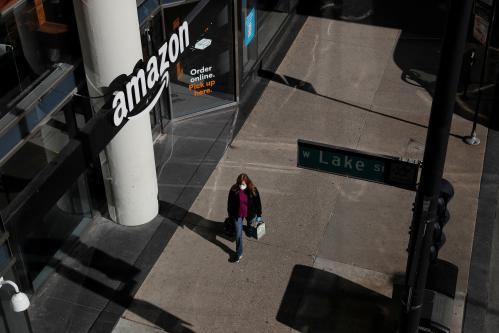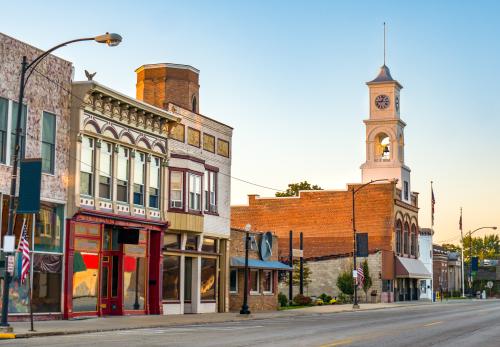Baseball occupies an immortal place in America’s public imagination: watching presidents throwing out the first pitch, eating hot dogs and Cracker Jack at the ballpark, remembering the songs, poems, and movies of our childhood. The sport’s evolution over the past half-century mirrors two of the most significant social and geographic changes in larger American society: racial integration and a migration from the Northeast and Midwest towards the Sun Belt. In this blog post, we examine how the geography and demographics of counties that host Major League Baseball teams have changed since 1950 with the league’s expansion.
Take me out to the Sun Belt
Baseball’s center of gravity in 1950 was firmly grounded in the Northeast and Midwest. The 16 MLB teams were located in 12 counties, stretching from Boston down the East Coast to Washington, and west to St. Louis. The spatial distribution of teams mirrored the country’s population centers. Over the next two decades, both the U.S. population and baseball moved South and West. The Boston Braves moved to Atlanta, the Brooklyn Dodgers moved to Los Angeles, and the Philadelphia Athletics to Oakland. Some legacy teams did move to other Northeastern and Midwestern cities (the Washington Senators to Minneapolis; the St. Louis Browns became the Baltimore Orioles). However, by 2018, roughly half of MLB’s 29 U.S.-based teams were located in the South or West census regions, similar to the spatial distribution of the U.S population[1]. The expanded number of teams and wider distribution slightly increased the population share that lived in a baseball county, from 14 percent in 1950 to 18 percent in 2016.

Professional sports teams, like opera houses and museums, need large numbers of people in order to fill the stands. Unsurprisingly, then, the counties that host MLB teams are some of the most populous in the U.S. The legacy MLB counties—those that have had teams since 1950—had an average population of 1.8 million in 1950, declining slightly to 1.6 million in 2016. The expansion counties—those that received their current baseball teams after 1950—were initially smaller than the legacy counties, but have grown rapidly over the past 70 years. Baseball expansion counties grew from an average of 830,000 residents in 1950 to nearly 2.4 million residents in 2016, an average annual growth rate of 1.6 percent. Counties that did not have MLB teams in 1950 or today grew at an average annual rate of 1.2 percent during this time, but still have fewer than 100,000 residents on average.

Population size is only one component of baseball’s business model: teams also need fans with sufficient disposable income to buy tickets, not to mention beer, hot dogs, and jerseys. In 1950, all the legacy baseball counties fell into the top quartile by county income. Three-quarters of the expansion counties were also in the top income quartile in 1950—perhaps a factor that attracted team owners looking for new homes. Expansion counties continued to be among the richest places in the U.S. in 2016. All of the legacy baseball counties were in the top income quartile in 1950, but have become relatively poorer over time. In 2016, only 42 percent of legacy baseball counties were in the top income quartile—still substantially more than non-baseball counties, but reflecting the declining affluence of older Northeastern and Midwestern metropolitan areas.
Buy me some poke and carnitas
The decades of baseball’s expansion South and West coincided with striking demographic changes across the U.S. population and within the league. Most U.S. counties were 90 percent white as of 1950; the legacy counties were only slightly more diverse. By 2016, both legacy and expansion baseball counties were majority non-white. The legacy counties in the Northeast and Midwest had substantially larger black populations, while one in three residents of the expansion counties (especially in Florida, Texas, and California) were Hispanic. Non-baseball counties are not only smaller and poorer than baseball counties, they have remained less ethnically diverse.

Racial changes are evident among baseball players as well. In 1947, Jackie Robinson broke the color line for African Americans in baseball. Three years later, the league was still nearly all white—more so even than the U.S. population. By 2016, both baseball and the U.S. population diversified considerably. The share of Hispanic players in the MLB is higher than that in the U.S. population overall, while non-Hispanic blacks and Asians are underrepresented in the MLB relative to the general population. The share of black baseball players hovered around 18 percent between 1975 and 1986, before declining steadily to current levels. The Hispanic and Asian shares of baseball players—like U.S. population shares—are continuing to increase. The increasing diversity of players and fans influences the character of ballparks, from concession stands to cheering sections, although owners, managers, and coaches remain almost entirely white.

Root, root, root for diverse teams
For most fans, baseball and other professional sports are primarily entertainment, but loyalties to teams and players can have serious implications. At their best, sports can bring together otherwise disparate neighbors: fans of different income levels, ethnicity, religion, and occupation can find common cause and identity in the fate of their shared home team. In extraordinary circumstances, this unifying effect can even transcend local boundaries: after the September 11th attacks, some long-time rivals cheered for the New York Yankees in the 2001 World Series.
But sports rivalries can also bring out less generous instincts, highlighting fissures in larger society. In particular, occasions when professional athletes use their platform to advocate for racial integration and inclusion have prompted ugly reactions from some public figures. Baseball players and owners have recently been less vocal about political and social issues than their counterparts in the NFL and NBA, perhaps because of the largely white ownership and management. Nonetheless, today’s diverse teams exist because of the activism of prior generations. Attracting and retaining talented players, regardless of race or national origin, makes America’s pastime greater than ever.
1. With apologies to our Canadian neighbors, we exclude the only MLB team based outside the U.S. (Toronto Blue Jays) from this analysis.
The Brookings Institution is committed to quality, independence, and impact.
We are supported by a diverse array of funders. In line with our values and policies, each Brookings publication represents the sole views of its author(s).








Commentary
They moved home plate! How baseball’s geography has evolved with the U.S.
March 28, 2018